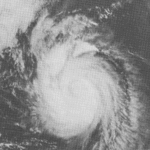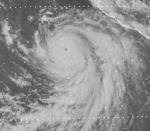1978 Pacific hurricane season
| 1978 Pacific hurricane season | |
|---|---|

Season summary map
|
|
| Seasonal boundaries | |
| First system formed | May 30, 1978 |
| Last system dissipated | October 21, 1978 |
| Strongest storm | |
| Name | Fico, Hector, and Norman |
| • Maximum winds | 140 mph (220 km/h) (1-minute sustained) |
| Seasonal statistics | |
| Total depressions | 23 official, 2 unofficial |
| Total storms | 19 |
| Hurricanes | 14 |
| Major hurricanes (Cat. 3+) |
7 |
| Total fatalities | Unknown |
| Total damage | Unknown |
| Related articles | |
| Category 1 hurricane (SSHWS) | |
| Duration | May 30 – May 31 |
|---|---|
| Peak intensity | 75 mph (120 km/h) (1-min) |
| Tropical storm (SSHWS) | |
| Duration | June 17 – June 20 |
|---|---|
| Peak intensity | 60 mph (95 km/h) (1-min) |
| Category 4 hurricane (SSHWS) | |
| Duration | June 17 – June 25 |
|---|---|
| Peak intensity | 130 mph (215 km/h) (1-min) |
| Category 3 hurricane (SSHWS) | |
| Duration | June 26 – July 3 |
|---|---|
| Peak intensity | 115 mph (185 km/h) (1-min) |
| Tropical depression (SSHWS) | |
| Duration | June 30 – July 2 |
|---|---|
| Peak intensity | 30 mph (45 km/h) (1-min) |
| Tropical storm (SSHWS) | |
| Duration | July 6 – July 10 |
|---|---|
| Peak intensity | 65 mph (100 km/h) (1-min) |
| Category 4 hurricane (SSHWS) | |
| Duration | July 9 – July 28 |
|---|---|
| Peak intensity | 140 mph (220 km/h) (1-min) ≤ 955 mbar (hPa) |
| Category 3 hurricane (SSHWS) | |
| Duration | July 13 – July 20 |
|---|---|
| Peak intensity | 115 mph (185 km/h) (1-min) |
| Category 4 hurricane (SSHWS) | |
| Duration | July 22 – July 29 |
|---|---|
| Peak intensity | 140 mph (220 km/h) (1-min) |
The 1978 Pacific hurricane season officially began May 15, 1978, in the eastern Pacific, June 1, 1978, in the central Pacific, and officially ended 30 November 1978. These dates conventionally delimit the period of time when tropical cyclones form in the eastern north Pacific Ocean.
Activity this year was slightly above average, with eighteen named storms forming. Five of those were tropical storms, thirteen were hurricanes, and six were major hurricanes that reached Category 3 or higher on the Saffir-Simpson Hurricane Scale. In the Central Pacific, a tropical depression and a major hurricane formed. Also, this season is the fourth most active season within the basin when counting on ACE Index, as the season had an index of 207. Atlantic Hurricane Greta crossed into the basin and was renamed Olivia.
A small tropical disturbance formed in the Gulf of Tehuantepec on May 27. It quickly accelerated southwest, before turning north late the following day. At this time, thunderstorm activity increased in coverage, aided by an outflow channel to the Intertropical Convergence Zone (ITCZ) the disturbance. Early on May 3, the disturbance's center become better defined, resulting in an upgraded into a tropical storm by 1200 UTC. After curving northwest, Aletta rapidly intensified, and at 0000 UTC on May 31, Aletta was declared a minimal hurricane. However, hours later, Aletta degenerated into a tropical storm. On the afternoon of May 31, Aletta turned north-northwest due to a trough over northwestern Mexico and a ridge over southern Mexico. At 1730 UTC, Aletta moved ashore just west-northwest of Zihuatanejo. After moving inland, Aletta rapidly dissipated.
A tropical disturbance developed on June 15 around 800 mi (1,285 km) west-southwest of Acapulco. After moving west-southwest, the disturbance became more defined until June 17, when it was upgraded into a tropical depression. At noon, te depression was elevated to Tropical Storm Bud. Late on June 18, Bud reached its peak intensity of 60 mph (95 km/h), only to start weakening the following day as it moved west-northwest over cooler water. Early on June 20, Bud weakened to a tropical depression. Shortly thereafter, Bud ceased to exist as a tropical cyclone.
Around the time Bud was developing, another tropical disturbance was developed 800 mi (1,285 km) to the east of Bud, but around 250 mi (400 km) west of Acapulco. Veering west-northwest, the small disturbance slowly organized and was designated as a tropical depression at 0600 UTC June 17. Eighteen hours later, the depression strengthened into Tropical Storm Carlotta. Thereafter, the system turned west-southwest south of a subtropical ridge in Bud's footsteps. Several hours after the formation of an eye early on June 19, Carlotta intensified into a hurricane. After becoming a hurricane, Carlotta tracked west-northwest, and rapidly intensified. At 0000 UTC June 20, Hurricane Carlotta abruptly intensified into a major hurricane (Category 3 or higher on the Saffir-Simpson Hurricane Wind Scale). Around 36 hours later, Carlotta peaked as a low-end Category 4 hurricane on the Saffir-Simpson Hurricane Wind Scale. On June 22, Carlotta started a gradual weakening trend as it turned northwest over cooler waters on June 22. Two days later, Carlotta weakened to a tropical storm. on 0600 UTC June 25, Carlotta degenerated into a tropical depression. Twelve hours later, Carlotta dissipated.
...
Wikipedia

















